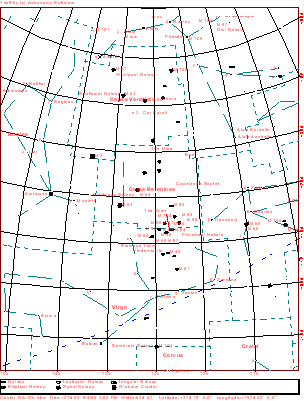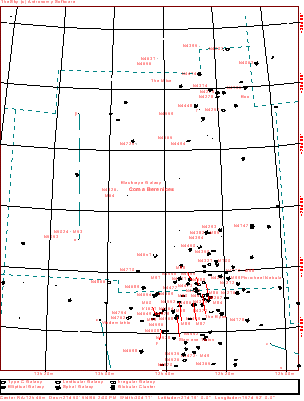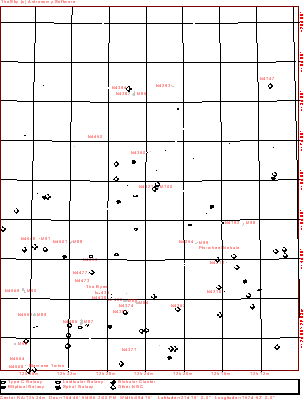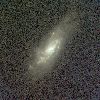
| Home | Deepsky Atlas | TheAstronews | Links | Solar System | ||||||

Hawaiian Astronomical SocietyConstellations: Coma Berenices -- An Egyptian Queen's Hair |
||||||||||
Queen Berenice was the wife of King Ptolemy III Euergetes (Benefactor) of Egypt. Berenice was quite famous for her beauty. She possessed beautiful, long amber tresses which she was really proud of.
War raged between the Egyptians and the Seleucids, and as the leader of the country, Ptolemy himself lead his troops in battle (he was avenging the death of his sister). Berenice (meaning "bringer of victory" in Greek) was deeply concerned for her husband's safety, and prayed every day for his return. She also asked the royal oracle Conon what to do. Conon advised the queen to offer her beautiful hair to Aphrodite (the goddess of love and beauty) for the safe return of her husband. Berenice did not hesitate, she was willing to sacrifice anything for her dear husband. Berenice cut her hair immediately and put her offering on the Altar of Aphrodite.
King Ptolemy returned home safely that evening. But Berenice's offering had disappeared by the dawn next morning. Upset, Berenice and Ptolemy demanded an explanation from Conon. The oracle waited till nightfall and took them outside under the clear dark skies. He pointed at the area between Leo and Bootes, and said "Look over there! Your offering is right there in the heavenly sky now. Zeus and Aphrodite were touched by your warm-hearted gesture, so the gods placed your hair in heaven to be admired by everyone." The royal couple lived happily ever after. You can still see Berenice's hair (Coma Berenices) in the spring sky.
Isn't that a lovely story? Isn't Berenice sweet? Well, no, she wasn't. The daughter of Magas of Cyrene (present day Libya), her marriage to Ptolemy in 245 B.C. served a political purpose, uniting Egypt and Cyrene. Magas opposed the union and brought in Prince Demetrius the Fair of Macedon to marry her. Berenice was nothing if not determined. She removed the obstacle to her marriage with Ptolemy by poisoning Demetrius. Still, she was reconciled to her father enough to plot later with him against her son, then ruling as Ptolemy IV Philopater (lover of his father). He did not particularly like his mother, though. Instead he had her killed, along with his uncle and brother (another Magas). He then married his sister (Arsinoe). Ah love.

Click the map for a 909x1199 version of the above. Click here for a map better suited for use in the field.

This is a more detailed view of the constellation. The map displays stars to magnitude 10, and deepsky objects to magnitude 12. Click here for a map better suited for use in the field.

Click here for a map better suited for use in the field.
 95k JPEG NGC4889 (Caldwell 35) is a fairly bright (mag. 11.4), somewhat elongated (2.8'x2'), elliptical galaxy, located in the center of the photograph. It sits 2.6° west of Beta Comae Berenices. Just another dull, uninspired fuzzy, but what a field! Just to the right (west) is NGC 4874 (mag. 13.1). To the left (east) and a little down (south) lies NGC4921 (mag. 13). NGC4911 (mag. 13.6) lies a little down and to the right of 4921. All these might be glimpsed with a 6" at a dark site. The photo shows dozens more. A big scope could have a field day. Slightly under a 1° field image from the Digital Sky Survey. 95k JPEG NGC4889 (Caldwell 35) is a fairly bright (mag. 11.4), somewhat elongated (2.8'x2'), elliptical galaxy, located in the center of the photograph. It sits 2.6° west of Beta Comae Berenices. Just another dull, uninspired fuzzy, but what a field! Just to the right (west) is NGC 4874 (mag. 13.1). To the left (east) and a little down (south) lies NGC4921 (mag. 13). NGC4911 (mag. 13.6) lies a little down and to the right of 4921. All these might be glimpsed with a 6" at a dark site. The photo shows dozens more. A big scope could have a field day. Slightly under a 1° field image from the Digital Sky Survey.
|
More difficult are two companions. NGC4712 lies just 12' west of NGC4725. It is another spiral described as very faint (mag. 13.1), fairly large (2.5'x1.1'), and elongated. NGC4747 lies 24' NE of NGC4725. It is faint (mag. 12.8), fairly large (3.4'x1.1'), and elongated. Burnham's reports a filament extending to the NE.
Image on the left is by Adrian Catterall. I was taken with a 5", f6 Astrophysics refractor with an ST7. It includes NGCs 4725, and 4712. Image to the right is processed from the Digital Sky Survey, and includes all three objects.
|
NGC4494 (Best 28), an elliptical galaxy, lies just over 1° to the west. Described as very bright (mag. 10.7), fairly large (4.7'x3.5'), and round, it brightens very abruptly toward the middle. The galaxy "grows" when viewed with averted vision.
Image is a mosaic from the Digital Sky Survey.
|
  NGC4559 (Best 29, Caldwell 36) is a very bright (mag. 10.2), very large (11'x4'), elongated (PA 150°) spiral galaxy that only gradually brightens toward the core. It sits 2° ESE of Gamma Comae Berenices. NGC4559 (Best 29, Caldwell 36) is a very bright (mag. 10.2), very large (11'x4'), elongated (PA 150°) spiral galaxy that only gradually brightens toward the core. It sits 2° ESE of Gamma Comae Berenices.
About the images: The color image on the left is an 83k JPEG composite of three grey scale images taken by the Palomar Observatory at different wavelengths, and combined using Paint Shop Pro. It shows well, areas of older yellow stars, red HII regions, and clusters of hot blue stars. The image on the right is a 76k JPEG, and a wider field image (just under a degree) from the Digital Sky Survey, showing many other galaxies.
|
 40k JPEG NGC4414 (Best 27) is the brighter of two galaxies located 3° north of Gamma Comae on the border of Canes Venatici. Dreyer calls it very bright (mag. 11.3), large (3.6'x2.0'), and extended (in p.a. 154°). It brightens to a stellar nucleus (Dreyer calls it a central star). The stellar nucleus requires about 12" and steady seeing. Some observers report a second stellar nucleus just south of the first. 40k JPEG NGC4414 (Best 27) is the brighter of two galaxies located 3° north of Gamma Comae on the border of Canes Venatici. Dreyer calls it very bright (mag. 11.3), large (3.6'x2.0'), and extended (in p.a. 154°). It brightens to a stellar nucleus (Dreyer calls it a central star). The stellar nucleus requires about 12" and steady seeing. Some observers report a second stellar nucleus just south of the first.
NGC4359 lies 34' to the north-west of 4414. Dreyer describes it as, quite faint (mag. 13.4), fairly much extended (3.5'x0.8') in position angle 90°. This one does not brighten much toward the middle. Not for the faint of heart.
|
 43k Labeled JPEG NGC4274 (Best 26) anchors the center of a field of four brighter galaxies, and a host of fainter ones. It is located in northern Coma 2° north-west of Gamma Comae. NGC4274 is described as very bright (mag. 11.2), very large (6.8'x2.5'), and extended in p.a. 90°. It has a much brighter nucleus that lies offset to the west, a feature visible in larger instruments. 43k Labeled JPEG NGC4274 (Best 26) anchors the center of a field of four brighter galaxies, and a host of fainter ones. It is located in northern Coma 2° north-west of Gamma Comae. NGC4274 is described as very bright (mag. 11.2), very large (6.8'x2.5'), and extended in p.a. 90°. It has a much brighter nucleus that lies offset to the west, a feature visible in larger instruments.
NGC4245 lies 29' to the west. It is described as quite bright (mag. 12.2), fairly large (2.9'x2.2'), very little extended, and containing an abruptly much brighter middle. It is resolvable (a single "R", meaning it is somewhat mottled in a 12". NGC4253 forms a triangle with 4274 (lying 22' north-west) and 4245 (16' north-east). When Dreyer calls something "very faint (mag. 14)" and "very small (<1')," you can believe him. NGC4314 lies 39' ENE of 4274. It is a barred spiral described as quite bright (mag. 11.3), large (4.1'x3.7'), and extended more or less in 150° position angle. Its brightens abruptly toward the middle. A star lies on the north-west tip. NGC4278 lies 20' SSE of 4274. Dreyer calls it very bright, fairly large, round, with a much brighter middle. It rates a single "R", meaning a 12" may show mottling. This is the first of three. NGC4283, at mag. 13, lies 4' to the north-east. It is still visible in a 6". Its high magnitude is offset by its small size (1.5'). NGC4286 (IC3181) lies 8' north-east of 4278. Shining at mag. 14.1, this one will be difficult. NGC4310 lies 31' ESE of 4278. Dreyer says it is faint (mag. 13.2), quite large (2.3'x1.2'), and a little extended (p.a. 128°). It is a pair with NGC4338 (mag. 15.3, 2.2'x0.2'), 22' to the SSE.
Image is a Mosaic from the Digital Sky Survey.
|
 11k JPEG One of Dreyer's remarkable objects, he calls this globular bright (mag. 7.7), condensed, and slightly irregular (12.6'), with stars at mag. 12 and fainter. M53 (NGC5024) is located in the middle of nowhere (south-western Coma), so it may be hard to find. Image by Pedro Ré, three, three minute exposures with a HiSYS 22 on a C-14 at f6. 11k JPEG One of Dreyer's remarkable objects, he calls this globular bright (mag. 7.7), condensed, and slightly irregular (12.6'), with stars at mag. 12 and fainter. M53 (NGC5024) is located in the middle of nowhere (south-western Coma), so it may be hard to find. Image by Pedro Ré, three, three minute exposures with a HiSYS 22 on a C-14 at f6.
|
 12k JPEG Nick Hudson of Aldermaston, England, took this image of the Black Eye Galaxy (M64 or NGC4826) on 26 February 1995 on his 14" f/6 Newtonian. A total of seven 99 second exposures were made, then combined using Christian Buil's MiPS image processing software. Dreyer describes the galaxy as a remarkable object, very bright (mag. 8.9), very large (10'x5'), elongated in PA 120°, and highly condensed. Larger telescopes can see the black dust band near the galaxy's center. 12k JPEG Nick Hudson of Aldermaston, England, took this image of the Black Eye Galaxy (M64 or NGC4826) on 26 February 1995 on his 14" f/6 Newtonian. A total of seven 99 second exposures were made, then combined using Christian Buil's MiPS image processing software. Dreyer describes the galaxy as a remarkable object, very bright (mag. 8.9), very large (10'x5'), elongated in PA 120°, and highly condensed. Larger telescopes can see the black dust band near the galaxy's center.
|
 7k JPEG M91 (NGC4548) is a bright (mag. 11.1), large (5.5'x4.5'), and slightly elongated barred spiral galaxy. It lies in south-central Coma, near the Virgo border and .8° east of M88. Image by Pedro Ré. 7k JPEG M91 (NGC4548) is a bright (mag. 11.1), large (5.5'x4.5'), and slightly elongated barred spiral galaxy. It lies in south-central Coma, near the Virgo border and .8° east of M88. Image by Pedro Ré.
|
 7k JPEG A bright (mag. 10.6), very large (7'x3'), and quite elongated spiral galaxy, oriented at PA 140°. M88 (NGC4501) lies in south-central Coma, near the Virgo border. 7k JPEG A bright (mag. 10.6), very large (7'x3'), and quite elongated spiral galaxy, oriented at PA 140°. M88 (NGC4501) lies in south-central Coma, near the Virgo border.
|
 6k JPEG Dreyer calls this galaxy (M85 or NGC4382) very bright (ok, mag. 10 isn't that bright), large (7'x5.5'), with an almost stellar nucleus. Image by Pedro Ré, two, three minute exposures with a HiSYS 22 on a C-14 at f6. 6k JPEG Dreyer calls this galaxy (M85 or NGC4382) very bright (ok, mag. 10 isn't that bright), large (7'x5.5'), with an almost stellar nucleus. Image by Pedro Ré, two, three minute exposures with a HiSYS 22 on a C-14 at f6.
|
  Images of the grand design of spiral galaxy M100 obtained with NASA's Hubble Space Telescope resolves individual stars within the majestic spiral arms. (These stars typically appeared blurred together when viewed with ground-based telescopes.) The individual stars astronomers are searching for a Cepheid variable stars. Astronomers use these stars to measure fairly accurately the distance to the galaxy. Astronomers hope to combine this information with other data to solve the puzzle of the age and size of the universe. Images of the grand design of spiral galaxy M100 obtained with NASA's Hubble Space Telescope resolves individual stars within the majestic spiral arms. (These stars typically appeared blurred together when viewed with ground-based telescopes.) The individual stars astronomers are searching for a Cepheid variable stars. Astronomers use these stars to measure fairly accurately the distance to the galaxy. Astronomers hope to combine this information with other data to solve the puzzle of the age and size of the universe.
Dreyer describes M100 (NGC4321) as faint (mag10.2) and large (7.5' x 6.4') with a condensed middle. It is located 2.5° SSW of M85 in south-western Coma.
|
 32k JPEG Described as another special object for larger scopes, M99 (NGC4254) is often called a "pinwheel." Located 7.4° west of Denebola, shining at mag. 10.2, and covering 5'x4.7', aperture helps here. Image from the Digital Sky Survey. 32k JPEG Described as another special object for larger scopes, M99 (NGC4254) is often called a "pinwheel." Located 7.4° west of Denebola, shining at mag. 10.2, and covering 5'x4.7', aperture helps here. Image from the Digital Sky Survey.
|
 8k JPEG Dreyer calls M98 (NGC4192) bright (mag. 11!?), very large (10'x2'), elongated in PA 152 and quite condensed. Image by Pedro Ré, two, three minute exposures with a HiSYS 22 on a C-14 at f6. 8k JPEG Dreyer calls M98 (NGC4192) bright (mag. 11!?), very large (10'x2'), elongated in PA 152 and quite condensed. Image by Pedro Ré, two, three minute exposures with a HiSYS 22 on a C-14 at f6.
|
If you have any questions about the Hawaiian Astronomical Society
please
(link requires javascript).